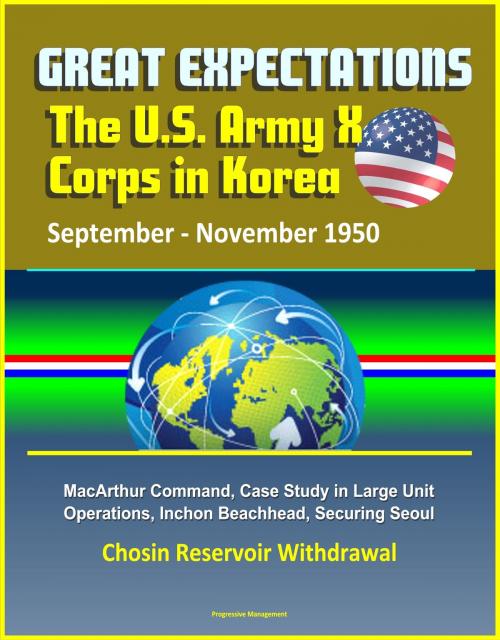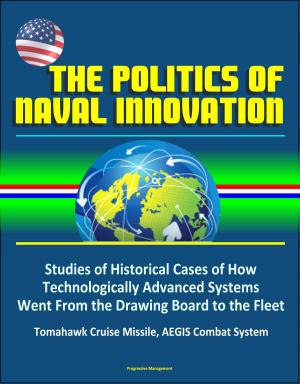Great Expectations: The U.S. Army X Corps in Korea, September - November 1950, MacArthur Command, Case Study in Large Unit Operations, Inchon Beachhead, Securing Seoul, Chosin Reservoir Withdrawal
Nonfiction, History, Asian, Korean War, Military, Strategy| Author: | Progressive Management | ISBN: | 9781370495702 |
| Publisher: | Progressive Management | Publication: | March 30, 2017 |
| Imprint: | Smashwords Edition | Language: | English |
| Author: | Progressive Management |
| ISBN: | 9781370495702 |
| Publisher: | Progressive Management |
| Publication: | March 30, 2017 |
| Imprint: | Smashwords Edition |
| Language: | English |
This excellent report has been professionally converted for accurate flowing-text e-book format reproduction. The U.S. Army X Corps as an organization presents a rich case study in large unit operations. It fought under General Douglas A. MacArthur's direct command in 1950 as one of two independent major subordinate commands, leading joint and multinational forces without the supervision of an intermediate army headquarters. In less than four weeks, MacArthur transformed a small planning team into an operational corps headquarters responsible for the successful amphibious assault at Inchon and the liberation of Seoul. However, just two months later, the combat-hardened corps narrowly escaped complete destruction by twelve Chinese Communist divisions as it withdrew from the Chosin Reservoir in northeast Korea.
This monograph examines the corps' organizational structure, operations process, and command environment using contemporary doctrine to discern the factors that affected its ability to expand the Inchon beachhead to secure Seoul, prepare for offensive actions in northeast Korea, and attack north to the Yalu River. Ultimately, no single consideration fully explains the corps' fate in late 1950. Instead, this monograph finds that the X Corps lacked sufficient time to build cohesive teams before commencing operations in Korea, neglected to consistently plan ahead, provide administrative support, or coordinate the actions of its assigned units, and proved unable to engender a command environment that fostered teamwork. Together, these factors largely affected the corps between its success at Inchon and the withdrawal from the Chosin Reservoir.
The X Corps as an organization presents a rich case study in large unit operations. It fought under MacArthur's direct command in 1950 as one of two independent major subordinate commands, the other Walker's Eighth Army. As a separate organization, the X Corps directed joint and multinational forces in offensive and defensive operations without the supervision of an intermediate army headquarters. Originally the planning team for Operation CHROMITE, in less than four weeks, MacArthur transformed this core nucleus of planners into an operational corps headquarters responsible for the invasion and the establishment of the Inchon beachhead. This task alone would challenge even the most experienced and cohesive corps headquarters and undoubtedly represented a palpable historical triumph for Almond and his fledgling organization. More poignantly, Inchon marked the beginning of a dynamic operational period on the Korean peninsula. Indeed, the Corps' actions in the ensuing months would span the spectrum of operations, test the limits and endurance of American military personnel and coalition partners, and underscore the advantages, challenges, and timeless lessons of large unit operations. It is appropriate to ask, therefore, what factors affected the X Corps' ability to conduct operations in Korea between the success at Inchon and the withdrawal from the Chosin Reservoir?
This excellent report has been professionally converted for accurate flowing-text e-book format reproduction. The U.S. Army X Corps as an organization presents a rich case study in large unit operations. It fought under General Douglas A. MacArthur's direct command in 1950 as one of two independent major subordinate commands, leading joint and multinational forces without the supervision of an intermediate army headquarters. In less than four weeks, MacArthur transformed a small planning team into an operational corps headquarters responsible for the successful amphibious assault at Inchon and the liberation of Seoul. However, just two months later, the combat-hardened corps narrowly escaped complete destruction by twelve Chinese Communist divisions as it withdrew from the Chosin Reservoir in northeast Korea.
This monograph examines the corps' organizational structure, operations process, and command environment using contemporary doctrine to discern the factors that affected its ability to expand the Inchon beachhead to secure Seoul, prepare for offensive actions in northeast Korea, and attack north to the Yalu River. Ultimately, no single consideration fully explains the corps' fate in late 1950. Instead, this monograph finds that the X Corps lacked sufficient time to build cohesive teams before commencing operations in Korea, neglected to consistently plan ahead, provide administrative support, or coordinate the actions of its assigned units, and proved unable to engender a command environment that fostered teamwork. Together, these factors largely affected the corps between its success at Inchon and the withdrawal from the Chosin Reservoir.
The X Corps as an organization presents a rich case study in large unit operations. It fought under MacArthur's direct command in 1950 as one of two independent major subordinate commands, the other Walker's Eighth Army. As a separate organization, the X Corps directed joint and multinational forces in offensive and defensive operations without the supervision of an intermediate army headquarters. Originally the planning team for Operation CHROMITE, in less than four weeks, MacArthur transformed this core nucleus of planners into an operational corps headquarters responsible for the invasion and the establishment of the Inchon beachhead. This task alone would challenge even the most experienced and cohesive corps headquarters and undoubtedly represented a palpable historical triumph for Almond and his fledgling organization. More poignantly, Inchon marked the beginning of a dynamic operational period on the Korean peninsula. Indeed, the Corps' actions in the ensuing months would span the spectrum of operations, test the limits and endurance of American military personnel and coalition partners, and underscore the advantages, challenges, and timeless lessons of large unit operations. It is appropriate to ask, therefore, what factors affected the X Corps' ability to conduct operations in Korea between the success at Inchon and the withdrawal from the Chosin Reservoir?















